Step-by-step guide to properly pruning pears in the fall
When growing pears on your site, it is important to properly care for the trees and prune them in a timely manner. This will increase the level of fruiting, prolong the youthfulness of green spaces and preserve the aesthetic appearance of the pear. Below is information on the rules for pruning pears in the fall.
Why prune a pear in the fall
Any green space needs systematic pruning. Thanks to a well-performed procedure, you can achieve:
- Creation of a powerful skeletal base, capable of withstanding the burden of weighty fruits.
- Crown thinning and modeling.
- Increased productivity.
- Ensuring normal access of sunlight to the crown.
- Lack of expenditure of energy for the formation of young branches and shoots. After pruning, the tree begins to direct all its forces towards the formation of fruits.
- Suspension of growth. The pear can reach 25 m in height. The voluminous green space casts shadows on other fruit trees. In addition, full harvesting in this case will be difficult to achieve.
- Improving the efficiency of spraying trees.
Pruning pear held in the spring and autumn. If the procedure is carried out incorrectly, it is possible to provoke an acceleration of the growth of young shoots, which will cause the depletion of the pear. In addition, it will affect the fruitfulness of the fruit plantation. In order not to make mistakes when carrying out pruning, you should reasonably approach the process and, first of all, familiarize yourself with the procedure for performing the procedure. It is also important to take care of the preparation of the necessary tool in advance.
Pruning for a bountiful spring harvest
After 36 months after planting pear seedlings, the shoots of the continuation of the skeletal branches and the central conductor should be shortened by 55-60 cm. In the zones of thickening, the crown is thinned out. A small percentage of branches are cut and tops are removed.
Fruit branches also need shaping. Annual branches that the grower does not plan to use to create the main branches must be shortened. It is necessary to leave only 30 cm of their annual growth. After 12 months, from these branches, you can begin to form fruit links, the length of which will reach 40 cm.
When growing varieties that are prone to strong branching, each of the annual growths must be left without shortening. After a couple of years, each growth is pruned into lateral branches. The process will contribute to the creation of fruit buds.
As soon as the pear enters the fruiting period, you can cut out the central conductor located above the branches of the second tier. It is important that the distance from the weak inclined branch remains within 35-40 cm. In the case of the formation of single skeletal branches above the first tier of branches, it is necessary to remove the conductor above the last single skeletal branch. Subsequent shortening implies the need to transfer this branch to a lateral fork.
Important! The height of the trees on the seed stock should reach 5 m. The height of the stem reaches 60 cm.
To ensure abundant pear fruiting, it is important to carry out in a timely manner:
- pruning trees, taking into account the recommendations described above;
- thinning the crown;
- limiting the growth of branches up to the sides of the row spacing.
When growing pears, characterized by weak branching and fruiting on ringlets, experienced gardeners recommend pruning branches of the skeletal and semi-skeletal type by 55 cm every spring. This will make it possible to increase yields and improve the quality of fruits.
If the growth of green spaces is weakened, and the length of the shoots that have grown over the year does not exceed 12-14 cm, the pear needs rejuvenating pruning. It is best to carry out such events in lean years.
To speed up the process of the entry of the fruit tree into the fruiting period, summer pinching of the shoots should be performed. This technique helps to retard the growth of shoots for a couple of weeks. At the same time, beneficial substances focus on the process of thickening of the shoots and contribute to the laying of new buds. It has been experimentally proven that pinned trees bear fruit several times more abundantly than non-pinned ones.
After pinching, new shoots begin to appear. They need pinching. The gardener should leave 3-4 leaves on each shoot. All shoots that choose the direction inside the crown are subject to pinching. It is also possible to pinch out competing conductors that tend to thicken.
Features of autumn pruning
It is unacceptable to remove too many shoots in one pruning. In this case, the fruit tree will focus all its energies on the process of restoring the branches. Soon, a large number of vertical branches will appear on the tree. In just 12 months, they will be higher than freshly cut shoots. Experts recommend pruning in the spring and closer to autumn. Below are the main features of the autumn pruning of pears.
- Autumn pruning should take place at the end of September, when the temperature has not yet dropped below 0C.
- First of all, shoots that grow at an angle of 90 from the stem are subject to removal.
- Then you can start removing shoots growing parallel or vertical to the trunk.
- When cutting, it is necessary to prevent cutting off excess parts and not leave hemp in the process. In order not to harm the pear, it is necessary to look at the annular influx of the bark. It can be easily seen at the base of growing branches. In this area, tissues are concentrated that contribute to the rapid healing and restoration of the tree. If stumps are left or if pruning is too deep, the recovery will take too long.
- When cutting down shoots, the thickness of which exceeds 3-4 cm, it is important to adhere to some rules: we make a small cut from the lower part, after which you can start sawing off the upper part of the branch. If the rule is ignored, the bark under the cut shoots is damaged and the unfinished part breaks under the weight of its own mass.
- Areas of cuts are processed with garden pitch. Otherwise, the pear will start crying, which attracts pests. Insect infestations negatively affect the health of the tree.
- It is unacceptable to make top dressing after removing branches. The pear will be able to take nutrients from its own root system.
Advice! Experienced gardeners recommend starting autumn pruning in early September.
Rules for pruning pears in the fall
There are several methods for pruning a fruit tree in the fall.
- The shortening method, in which parts of the shoots and young growths are cut off. This technique makes it possible to reduce the growth rate of the tree in height, thin out the green space and improve the quality of the fruit. The growth branches are completely removed.
- The thinning method allows you to increase the access of sunlight to the inside of the crown. In this case, the growth of foliage is stimulated, the volume and quality of the crop increases, and the level of protection of the tree from the effects of pests is increased.It should be borne in mind that the thinning method does not promote the growth of the remaining shoots.
Horticultural experts have made an additional classification of pruning varieties, depending on the purpose of its implementation:
-
- forming, giving the crown a certain type of crown, stimulating the overgrowth of fruit wood;
- supporting, regulating the number of fruiting branches and increasing productivity;
- rejuvenating, prolonging the period of fruiting and the life of the planting, activating and renewing the process of fruit formation.
Before you start pruning, you need to arm yourself with tools. In the process of work, you have to use:
-
- secateurs;
- lopper;
- sharp knife;
- saw on wood;
- scissors;
- garden var.
Note! The cut areas must remain flat. It is very important that there are no torn fibers in these places.
To avoid contamination of the pear, it is important to clean all blades on the tools.
Fall pruning step-by-step process
- For the first pruning, you must use a formative variety of procedure.
- At a preselected height of the stem, a kidney is selected, which grows in the plane of the row.
- Other buds growing above this bud (3!) Are removed. This helps to ensure the free growth of the conductor. The branches begin to grow at the right angle.
- 5 the kidney from the location of the first we leave. It allows the second branch to develop.
- 6, 7, 8 kidneys are removed.
- On top of the 9 kidney, we make a cut of the one-year process.
- 24 months after planting pear seedlings in open ground, the central conductor should be 20-50 cm higher than the rest of the shoots. If necessary, the remaining shoots can be shortened.
- Skeletal shoots are slightly shortened.
- Once the pear is 5 years old, the center conductor can be shortened to the beginning of the first skeletal branch. The central part of the crown can be kept open. However, it is very important to avoid thickening.
- Any shoot that is directed to the center of the crown is removed without regret.
- Top branches, which are directed to the trunk, are cut off.
The nuances of trimming
Depending on the type of pear that needs pruning, it is worth highlighting the nuances of pruning.
Old and young green spaces
Unfortunately, inexperienced gardeners are not aware that pruning old and young pears has its own characteristics. It is necessary to select a pruning scheme depending on the age category of the tree. It is also worth taking into account the peculiarities of the event to remove unnecessary branches, which are presented below.
- In order to properly shape the crown, the base of the pear trunk should be cut every 12 months. It is best to give the pear a pyramidal shape.
- In the case when the tree is more than 2 years old, pruning is best done in 2 stages - in autumn and spring.
- In the fourth year of life, the tree needs to plan the skeleton of the branches for the second tier.
- In the fifth year of the life of a green plantation, young shoots are formed much less frequently. When thinning a tree, do not remove fruit-bearing branches. You can only cut off old shoots and branches that do not bear fruit.
Note! After rejuvenating pruning, the harvest for the next season will not be plentiful. Gradually, the fruiting process will improve.
Columnar pear
12 months after planting pear seedlings, it is necessary to cut the main branch at a distance of 55 cm from the soil surface. The cut is made in the growth zone of the kidney. It is very important that the cut is located on the side opposite to the inoculation. After a couple of years, the central trunk at a distance of 25 cm from the location of the growth bud is cut off. The growth bud should be located above last year's shoot. By the 4th year of life, the tree is overgrown with 8 branches. it is necessary to leave extremely strong shoots. Their number after the procedure should not exceed 4 pieces.The center conductor should remain 20-30 cm higher than other shoots. All branches are cut at the same height.
Dwarf pear
In April, after planting a seedling, experts recommend cutting a dwarf pear, leaving a plant whose height does not exceed 65 cm from the ground surface. Two-year plantings need to remove all shoots on the trunk up to a height of 45 cm. The central guide is shortened by 40 cm. Dry branches are removed without regret.
Care after pruning
Slices with a small diameter are able to heal on their own. They do not need special processing. Each slice, the diameter of which is within 2-3 cm, must be decontaminated. The cut area will tighten on its own. Large cuts, the diameter of which exceeds 3-4 cm, should be processed according to the following scheme:
-
- the wound after circumcision is cleaned of roughness with a sharp garden knife;
- using a brush, the saw cut is treated with a disinfectant, which will prevent infection from entering the wound;
- for the purpose of drying, the saw cut is left for a couple of days;
- damaged wood is treated with garden varnish (do not touch the edges of the cut).
Experienced gardening tips
Horticultural experts recommend:
- Remove diseased and dry branches without regret. After freezing, the bends can break off and damage healthy parts of the green space.
- Remove most of the branches that grow at a 90 ° angle.
- Do not leave hemp and burrs on the cuts.
- Carry out pruning in stages - in spring and autumn, in order to less injure the pear.
With proper care of the pear, you can grow a healthy tree that will delight you with a bountiful harvest every year. Carrying out annual pruning will make it easy to harvest and rejuvenate the tree.
Detailed instructions for pruning pears for beginners:



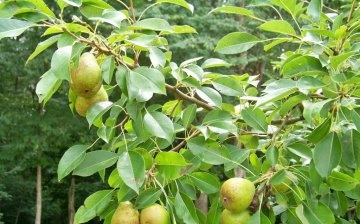
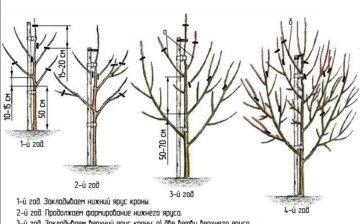
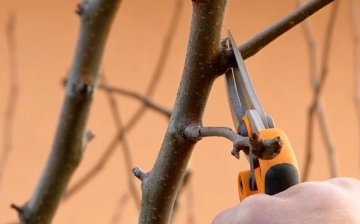



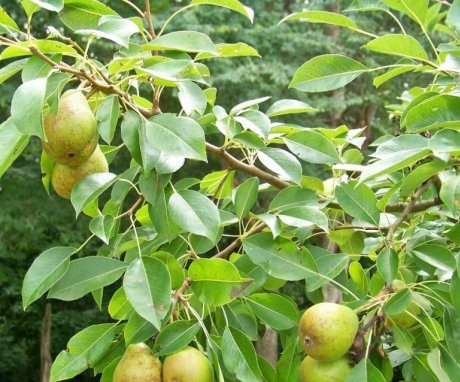
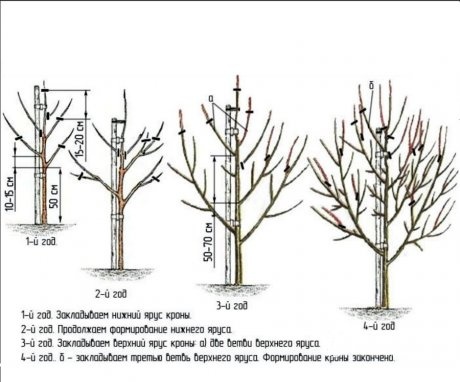
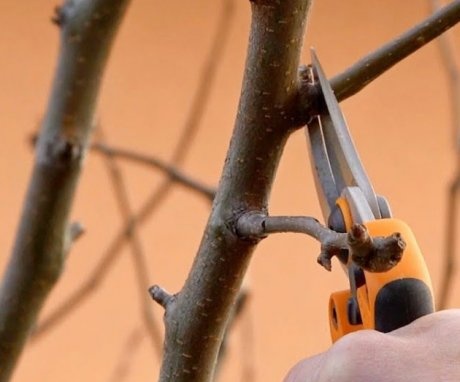
We practically do not prune a pear and it has a thickened crown. Probably for this reason the tree bears fruit in a year. This year, in the fall, according to the recommendations in the article, I will trim.